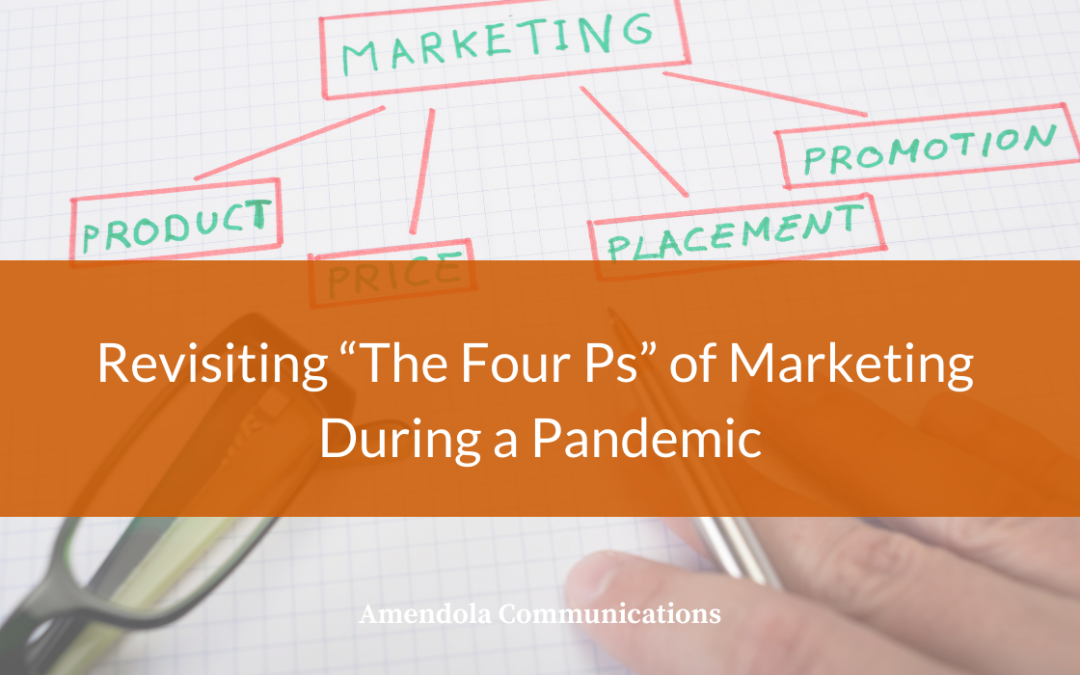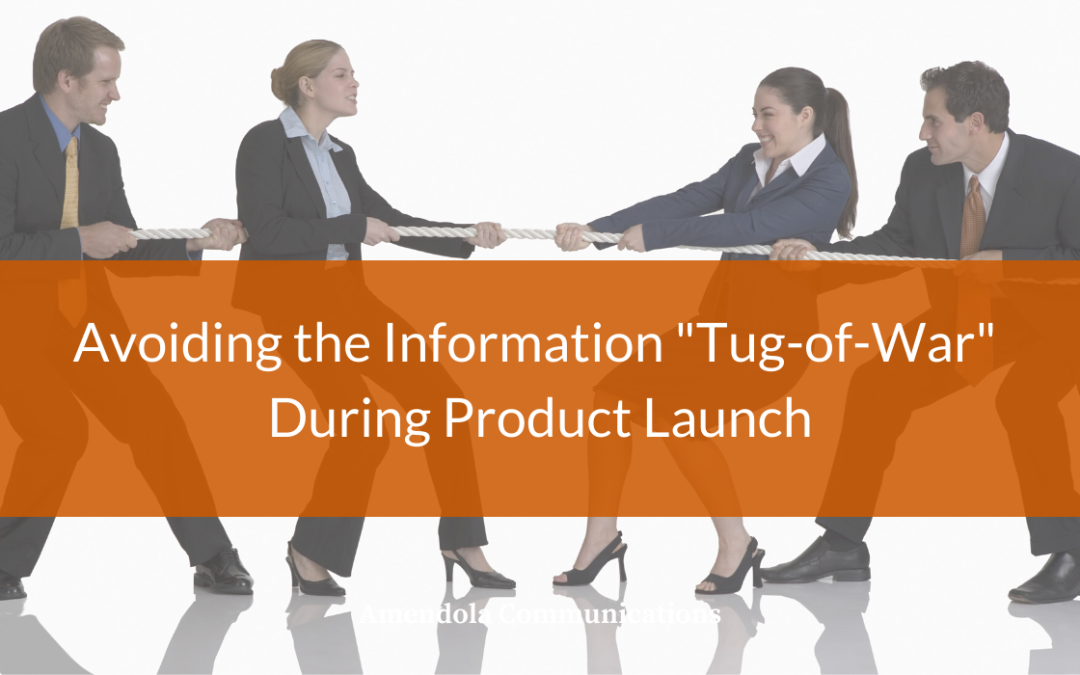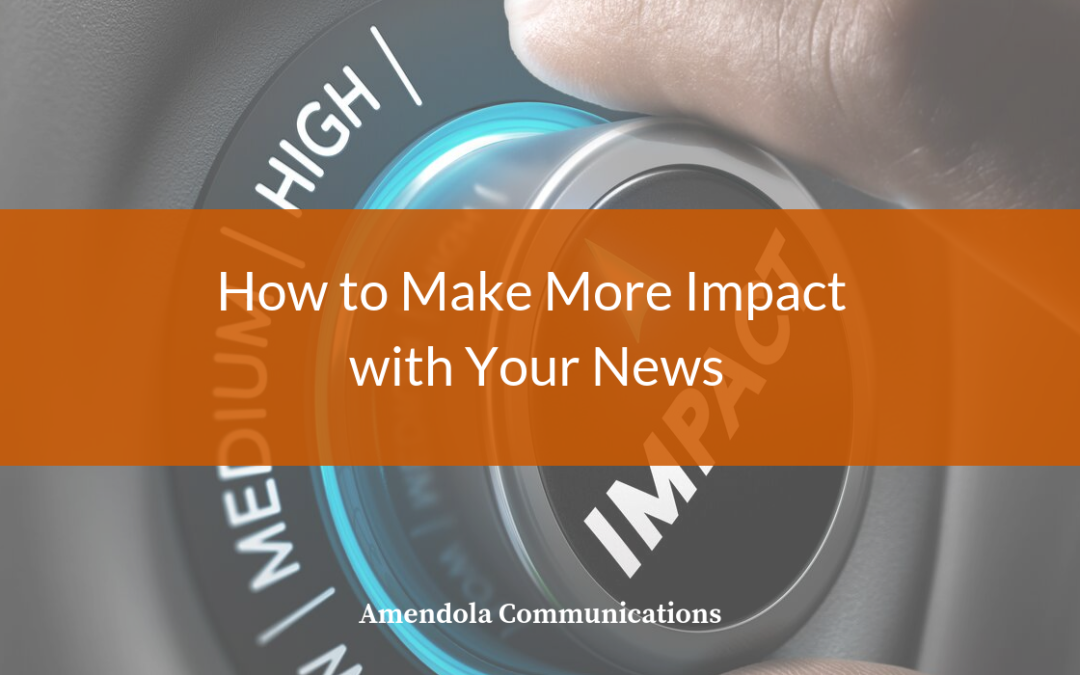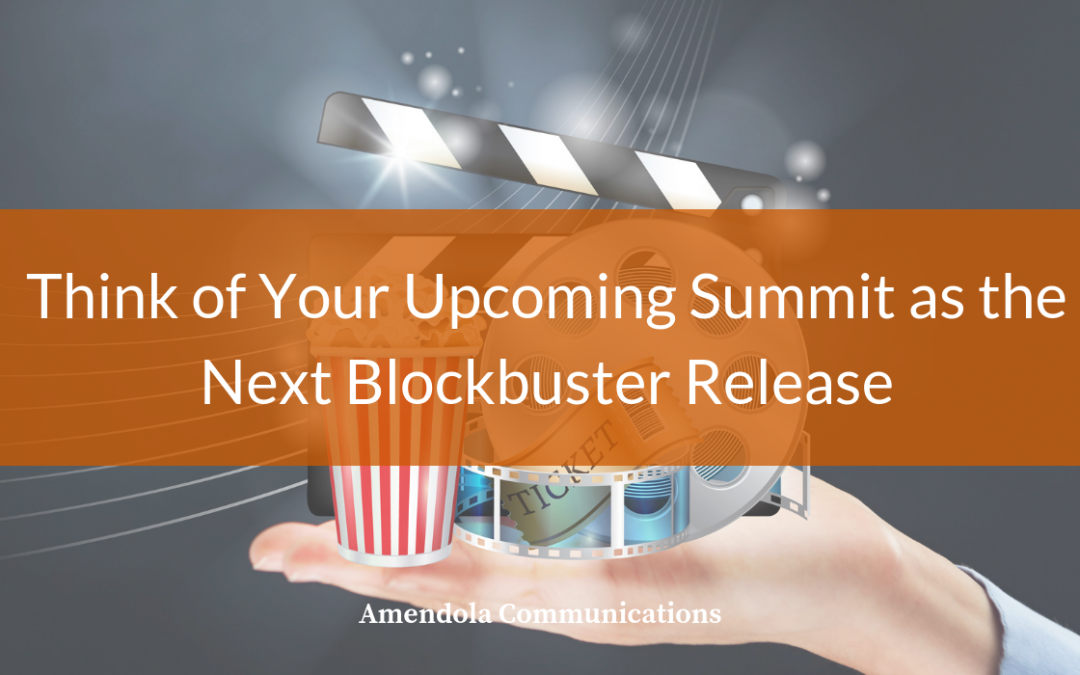
by Chris Currington | Oct 7, 2020 | Blog
Whenever asked to come up with a marketing plan, many people refer back to the “The Four Ps of Marketing” and use them as the basic foundation to develop an integrated strategy.
During the COVID-19 pandemic, a lot of healthcare and health IT companies have had to totally rethink the four Ps—whether they know it or not. And, they’ve had to do this as fast as possible while trying to save lives—of frontline workers and infected patients—while remaining relevant and profitable.
Here’s an example. Currently all eyes are on the biopharma industry to see how quickly they can develop a vaccine that will effectively stop—and hopefully eradicate—the coronavirus.
- The “P”roduct here is the vaccine, and there are many companies testing theirs to see which offer the best and safest results.
- But have you also noticed a lot of the “P”romotions that these companies have been making in the national news? So far, none of them have been paying for these promotions—and that’s an important point of clarification—not all promotions are paid.
- There are also a lot of national arguments on the “P”lacements of the vaccines. How will the vaccine be distributed and who will be first in line to receive it? How will they know it’s available and where to get it?
- And of course, we’re also hearing a lot or rumblings about the “P”rice of the vaccine. Will it really be free (someone has to pay for it) or will there be a hefty cost when people pull up their shirt sleeves?
Because we’re in a pandemic, the whole healthcare industry has had to deal with its effects on their individual products and services. Here’s a recap of a few observations of what’s been happening.
Product
Because of COVID-19, many—if not all—health IT companies have had to take a very hard look at their products and solutions and how they can help health workers deal with and provide care to those in need.
Some of the products are back-end solutions that integrate with technologies such as EHRs—to provide faster service and track results. Certain companies may deal more directly with healthcare coordination or how data is being used and sent, while others may provide community-based services to those who are most vulnerable. And as mentioned above, many are dealing with therapeutics that help in delivering care to those affected with the virus.
Placement
Directly related to the product or solution is where and how it will be used. This will have an effect on how it will be marketed and determine the channels for those efforts.
Right now, in healthcare, certain products (think thermometers, COVID-19 tests, ventilators, etc.) are moving very quickly all around the world. But it takes sophisticated logistical operations to get equipment where it needs to be.
But this also affects how the public is informed and how the product gets used. For example, we’ve heard several instances of how someone may be feeling symptoms related to the virus but has absolutely no idea about where to go to get a test.
Promotions
This is probably the most confusing and difficult of The Four Ps to navigate during the pandemic. With so many companies wanting—and deserving—earned media placements, many news outlets are overwhelmed with requests. Having the right relationships with the media, and offering them true, compelling and factual stories is key to making sure products and solutions receive the attention they deserve.
Paid promotions are an obvious possibility, but with so much information “out there” companies will need to be very analytical, specific and targeted to reach their audiences and cut through the noise. Social media is also a good option to promote a product or solution, but knowing the right channel and frequency are keys to getting attention, followers, likes and shares.
Price
The most compelling of the Four Ps to the consumer of a product or service is the price! Remember all the fears about toilet paper and hand sanitizer shortages, and efforts to control supply and demand?
Many healthcare and health IT companies—in order to meet needs and create a common good for care delivery—provided their solutions for free. But they can’t do this forever because they’ll go broke. And, in an unstable economy, pricing dilemmas will surely consume many of these companies’ time—while trying to maintain and salvage relationships with clients and customers.
As has been demonstrated time and time again, The Four Ps of Marketing create the formula for a winning strategy and a profitable company. During the COVID-19 pandemic, many companies have had to revisit all the Ps to make sure their product or solution gets where it needs to be or does what it can do for health workers.
Products, places, promotions and price are now more relevant to healthcare delivery—and saving people’s lives—than they have ever been before.

by Chris Currington | Jul 8, 2020 | Blog
Here’s the scenario. A new product or solution has been developed. Sales and marketing — because they have tangible goals that must be met in a certain timeframe — want to rush out the product launch so they can start selling it.
However, other departments within the organization — such as legal and finance — may take a more cautious approach. Legal doesn’t want to get the word out too quickly because there are too many items that need to be checked off the list first, such as the accuracy of competitive intelligence and any contractual obligations about promotions and sales. Finance wants to make sure that the pricing structure and cost of the product or solution are “just right,” and they need to make sure that future projections are accurate for budgeting and planning.
Working in corporate public relations, and marketing communications specifically, we’ve seen the push and pull between product development, marketing, finance and legal departments over when and how much information to give the general public and captive audiences. We’ve even witnessed arguments — in person and over email — about how much information should be released and how fast.
Here’s what an abbreviated conversation looks like.
Sales: “When is that product going to be ready, we need to start selling immediately!”
Marketing: “All promotions are ready to go. We’ve told Sales that they can start selling next week.”
Finance: “Hold on. What’s the pricing structure and do you have buyers willing to pay for it? If so, how many buyers do you have? And have all promotions and pricing been approved by Legal?”
Legal: “Who approved all of the promotions? We don’t have any contracts that are ready to be presented to customers.”
CEO: “Everyone stop. We need to get our strategy and information aligned before we make any entry into the market with this new product.”
Determining the who and the when
Look at developing marketing communications and the release of information in terms of three phases: product development, product launch, and post-launch.
During the product development phase, there should be several departments at the table. This would include product, marketing and legal, with executive oversight. Product is there to determine the path forward, timing and development efforts. Marketing is at the table to help with competitive intelligence and potential messaging as the product goes through testing. Legal is there to cross check the accuracy and legitimacy of competitive intelligence, as well as the claims about the new product that can and cannot be made. And the executive provides oversight to make sure everything runs smoothly and that the appropriate individuals are held accountable for their team’s efforts.
Preparing for product launch
As we approach the product launch phase — and because everyone has been working in tandem rather than in their silos — information starts to get approval and a go-to-market strategy starts to unfold. Based on testing, product is working out the final details before launch.
However, this is where things could get complicated for marketing and communications. By this point marketing has probably finalized the product name, gotten the legal approvals and trademarked or registered it. But what are we going to say about the product in order to promote it effectively, yet not tip our hand to our competitors? What remains proprietary and what can be shared? If we share too much — or if we say too little — our competitors will seize on it.
This is where marketing and legal engage in a very fine dance — with marketing getting creative and legal providing the checks and balances.
Marketing and its copywriters should begin carefully crafting the messages that were uncovered during the product development phase, and pressure-test them with confidential audiences. Here, the audience reacts to certain emotions and feelings elicited by the actual text, and copywriters can refine messaging based on those reactions. Some messages will get axed, some will get nuanced and some will be born.
After the messages have been created, then bring in the visuals that will align with those feelings and emotions that were uncovered. The visuals can be used for the collateral, website, presentations and any other materials that will be produced.
During the pre-launch phase, legal is also approving the messaging, making sure that all claims are factual, nothing crosses the line, and most importantly, that not too much information will make its way into the public domain. Legal can also help determine the intellectual property (IP) that can be shared with the general population as well as what IP can be shared with the target buyers.
With marketing and legal working as allied forces — rather than opposing forces — the whole product launch will be much easier. And, when materials are presented to sales — after they’ve been fully vetted — a lot of heartburn will have been avoided because sales will have clear parameters about what they can and cannot claim about the product.
Before product launch, marketing should be working with finance and sales as well. Together, they will need to work out product pricing, target audiences, actual buyers and projections. Sales will be determining realistic goals and anticipating the product launch date, and finance will have a detailed understanding of projected revenue.
Now that everything has been worked out and all systems are set, the product can be launched. Having worked together in unity, hopefully, all systems are a go and the information tug-of-war can be avoided — or at least made easier — and the post-launch phase is merely a matter of assessments and simple adjustments to ensure customer satisfaction.
The conversations should then be something like this.
Sales: “We’re ready.”
Marketing: “You have what you need.”
Legal & Finance: “We’re good. Good luck!”
CEO: “Good job, everyone.”

by Chris Currington | Jan 22, 2020 | Blog
The first rule of real estate is “location, location, location.” Anyone who’s ever been in the market to buy or sell a home has been told this by a family member, friend or agent. But when you’re buying a house where exactly is the best location? The answer: It depends.
Truth told, there are many variables when you decide to buy a home, most notably price and cost. You may want to live in a certain location, but the price of the houses there may not fit your monthly mortgage budget. So you have to look for a different location.
Another example: let’s say you want to buy a house in a historical part of a city. The prices may be cheaper for the houses, but there may be a lot more maintenance and cost that goes into it.
In marketing, the question often arises, “how often should I be reaching out to my prospects so I can close a sale?” The answer here is the same as buying a house: It depends.
Some of the factors determining your approach to outreach are sales goals, clearing the shelves, price of the product and the length of the sale. The following are some points to keep in mind when determining how often you want to reach out to potential buyers based on your approach to the sales process.
The Hunting Approach to Sales and Frequency of Contact
In this approach to the sales process, the service or good could be a one-time acquisition or it could be purchased several times. When gaining leads, the company looks at the population of prospects, and then answers the question, “who am I going to go after?”
Next, they determine the outreach approach based on the “target’s” buying journey and how they gain information. And then they hunt.
With this approach, what one hopes to achieve is an initial buy and then the possibility of repeat customers. Because of this, they need to determine how often to reach out and provide prospects with pertinent information to get them to buy. This approach may be applicable to both business-to-business (think Dunder-Mifflin) and business-to-consumer relationships.
Groupon is a good example. If you’ve ever given your personal email address to Groupon, you’ll soon find that emails show up as frequently as daily. And there’s a reason. It’s because the sales and buying opportunities change daily, and the buyer has to act fast or could miss out on the deal.
Another example is if you have an Amazon Prime account. Emails show up almost daily, because the discounts and shipping options change daily as well.
But what about other sales and discounts that don’t change as frequently? In this instance, too many emails can sometimes be annoying because the offering isn’t necessarily changing that often.
In these instances, it’s important to assess when the amount of outreach becomes an annoyance. What you want to avoid is prospects hitting the “unsubscribe” button and losing their business or never getting it in the first place.
Examples of companies that may reach out too often are online meal kit delivery services, movie theaters and car rental companies. The questions to answer here are: is the meal kit option changing in the next month, do I need to rent a car this week, and are the movies switching out today? If the answer is, “probably not” then it’s important to watch how often emails are sent.
The Gathering Approach to Sales and Frequency of Contact
In this approach, the company is trying to build a relationship for the long-term. They start with some of the same steps as the hunting approach determining the appropriate population, looking at their “options” to start a relationship with and how they gain information. And then they date.
In the gathering instance, the cost of the good or service is usually (but not always) much more expensive than the hunting approach. As such, the language used in these company’s messages is also different, focusing more on the benefits of the product (a new HVAC unit), the return on cost (a car) and a tie to an emotional state (a diamond ring).
For B2C relationships using the gathering approach, outreach is common but usually not as frequent as the hunting approach. Sure, there may be a sale on a certain model of new car, but chances are that sale isn’t ending tomorrow. And, a bachelor looking for an engagement ring is probably going to take his time to find the right one; not because he got an email every day for a week.
When gathering customers, the time it takes to sell the good or service, or close a deal, can take a lot longer than the hunting method as well. So, determining the cadence of outreach to prospects is also important for the company to note. For example, if a company knows that a buyer isn’t going to make a decision in the near future, then daily emails are probably not a good idea.
Determining cadence of outreach is particularly important when developing B2B relationships, because these deals can cost millions of dollars and take m onths to close, and when that money is on the line, the buyer values a long-term relationship and is gauging what can be expected.
Something to consider here is the level of the individual that the outreach is being sent to and how often messages are being sent. For example, overwhelmed by the amount of email in his or her inbox, if sent too often, a message has a good chance a C-level executive will delete it. Or, these people may have a separate email box for those messages and they end up eternally ignored.
If you have a good email address for someone at this level, then don’t bother them too much with your messages. Consider who’s making the buying decision and dating you in return probably an influencer at a lower level in the organization who’s more likely to read and receive your invitation to engage. So perhaps more of your energy and messaging should be focused at this level.
Conclusion
Where have we gotten with the answer when determining how often to reach out to your prospects? It depends.
When buying a house, once you get past location, logic and good advice tell you to look at what you can afford, the most (and best) house you can get for your money, and the community amenities around it.
When determining your email and outreach campaigns, use logic and good advice to determine the type of relationship you want to develop with your prospect,
their journey to making a decision, and then how often you need to reach out.
There’s really no right answer for the question about frequency just a better answer depending on your good or service and the relationship you hope to make. But whatever you decide, keep in mind what it will take to keep your buyer(s) engaged and avoid hitting the unsubscribe button.

by Chris Currington | Sep 25, 2019 | Blog
You have a piece of fantastic news. Congratulations! But what are you going to do with it now so you can get maximum exposure of it?
We hear many times, “I have a great story, let’s write a press release!” Could be a new solution offering, the latest customer success story, or perhaps even a new hire who has a lot of experience and is of high caliber. This always leads to bigger questions, such as: “How does it fit into your broader marketing efforts?” or “What does publicizing this do for you?”
Anything that is truly newsworthy isn’t a one-off “mention.” It’s what you do with it afterward that creates the bigger buzz and gets the most attraction for your company or organization.
Use it to create broader campaigns
This is especially important for a new solution or product launch. You’ve taken the time to go through the tedious development and testing phases, which is great for the worth of the product. But, do you really just want to issue a press release, or do you want to use the news as a springboard for broader exposure? Consider what you’re going to do after the press release has been issued.
Today, social media and advertising can be excellent ways to capture leads and generate sales. Tie whatever news you’re creating to the appropriate social channels and use them to keep promoting the product offering. And consider how the news translates to the customer journey. If you want to attract customers to your website, ask yourself how you will use the news you create to drive traffic there.
Remember where it falls into integrated marketing efforts
Just because you have a new piece of news doesn’t mean it shouldn’t tie into your broader marketing efforts. Many industry publications provide their annual editorial calendars. These can be incredibly important as you develop your news cycle and combine it with your paid media efforts.
For example, let’s say a trade publication has dedicated its March issue to a topic that matches perfectly with the research being performed by one of your thought leaders. You may want to consider skipping the news you’d planned for him or her in January and wait until the publication’s March issue. This way, not only are you releasing the news publicly, you’re more likely to get an interview by the publication at the same time, increasing the exposure for your thought leader even more.
Keep the next campaign in mind
If you want to use your news as a way to reach your target audiences, consider having a cadence of news releases, and have them coincide with various campaigns. This is a great way to promote your products and/or solutions throughout the year. For example, you can look at your integrated calendar, and have press releases occurring every month. But don’t let the releases stop without further promotions. Have an entire calendar of items happening – and remember that it doesn’t matter if they’re overlapping at various times.
This is also where your automated marketing efforts can produce excellent results. Have a press release prepared, plan to issue it, then follow it up with an infographic that brings people to some form of gated content. Keep doing this throughout the year, and you could possibly have a never-ending list of leads constantly coming to you.
Remember what’s newsworthy and what’s noteworthy
Just because someone comes to you with something they feel is newsworthy doesn’t necessarily mean it is. What’s harder is trying to convince him or her that what they have in mind may not capture their audience as compellingly as they intend. Finding the right outlet may be the best way to convince them that there could be a better – and less time consuming – way.
For example, a company could spend thousands of dollars recruiting a new senior vice president. They find the ideal candidate, with the right education and background, and they want to point that out to their competitors. So they propose a news release. However, industry publications and business journals throughout the country have new-hire and people-on-the-move sections. Perhaps it would be a lot easier writing up something simple, having it placed in one of these outlets, and then promoting on the company’s website and through social media. You may find that you get the same, if not better, results with a lot less effort and expense.
When planning your overall news cycle, keep these things in mind: newsworthiness, breadth, integration and the big-picture campaigns. Don’t let your stories fall flat when there are so many ways to promote them and easily available to you and your organization.

by Chris Currington | Apr 17, 2019 | Blog
You’ve invested substantially in your upcoming trade shows, congresses, conferences or summits (collectively referred to as “summits” in this blog piece). Speaker submission forms. Sponsorships. Booth-install, technology and set-up. Videos. Meeting spaces. Air fare. Hotel blocks. Meals and entertainment. Just to name a few of the common and worthwhile expenses.
But, how do you make your speakers stand out from the others? How will you pique interest and draw attendance? How can you show target audiences the value in your solution and engage with them?
Think about your upcoming summit as if you were bringing a new movie to theaters building anticipation and excitement for your specific offering, making sure your audience gets an entertaining learning experience and then at the end leave them wanting more.
1. Coming Soon! (Build Anticipation)
You should begin preparing months in advance of the summit. If possible, make sure the save-the-date goes out to key audiences (including internal sales and marketing teams) during the previous year’s summit. If that isn’t possible, then send out the save-the-date as soon as your appearance at a summit or a speaking opportunity is secured.
During the months leading up to it, create talk tracks for sales and account teams to help drive attendance to the summit. Talking points can also be used in emails to clients, customers and prospects. Develop landing pages and digital flyers with information about the summit and speaker.
Something to keep in mind is, if you’re securing speaking sessions or educational forums, make sure they offer continuing education credits. This helps to build interest in your key audiences and leads to better attendance.
As the show draws closer, supply your sales and account teams with social media posts that they can easily post and share. These take only minutes to compose and can be a simple push to their Twitter, LinkedIn and Instagram accounts.
2. Showtime! (Creating a Meaningful Experience)
From the time the summit opens, you should be taking advantage of opportunities to engage your appropriate audiences. There are various media and formats to create a dialogue and draw attention to your company and solution offering.
If it’s allowed, during keynotes and other speeches, you could consider live-streaming them for your customers, clients and prospects who are unable to attend. This is also a great way to create a “pull” and desire to attend the show in the future.
For social media, make sure that you have an ambassador who is taking pictures and writing recaps of sessions that link to next year’s save-the-date for the show. Include something in the social post like, “Reserve your spot NOW for next year’s summit!”
If you have clients on-site, help them share their stories through testimonials. You can also have a videographer, who is visible to other attendees, grabbing people in the hallway or aisles and asking them about their conference experience, what they’ve learned and their most important takeaways. This is an excellent way to create buzz and get people talking. It also provides content for a recap video to promote future conferences and can be an amazing tool for digital campaigns.
Be sure to have a booth or pop-up in the vendor display area. In addition to having a space to demonstrate your solution, this gives you a meeting area for clients to discuss their successes and prospects to ask questions and sign up to learn more. And, make sure that sales and account management teams are taking notes so they can conduct proper follow-up opportunities. To keep attendees engaged and returning to your booth, consider some sort of raffle or giveaway.
If you have speakers and clients presenting, create polls during the sessions. This gives another chance to engage the audience and gives you statistics and material to post on social media. Build in an appropriate time for questions and answers those, too, can be posted on social channels. For future material, assign writers to record the sessions and create bylines or post-session articles to add to your marketing content pipeline for months to come.
3. Now Streaming! (Post Show Tactics and After Effects)
As soon as the show ends, issue a press release with a recap of any important announcements, how many people attended, a list of organizations that attended (if it’s impressive) and any awards that may have been given to your customers or clients. Be sure to include client quotes”¦especially those related to your product or solution.
Create a virtual summit, in a webinar format, with a series of the best sessions. You may need to fill out forms and work with the show’s continuing education people, but it may be possible to offer continuing education for the virtual summit as well.
For those who attended the summit, consider creating a gated microsite, with links to all materials from the show’s sessions, and a link to the next year’s save-the-date. You can also include links to the virtual summit schedule, registrations and the media recap session that was produced during the show (or post-show) as well.
Finally, email your target list to keep them engaged! Develop a cadence of one-a-month, with key takeaways, follow up materials and calls to action.
To get the most from the investment you’ve made in summits, have a strategy and devote the time to plan, execute and follow-up. Remember that the latest big blockbuster movie had many resources devoted to its preparation and release, as well as continuing its popularity after it left theaters. With the tactics in this blog, hopefully you, too, will have a summit that’s a hit for a long time to follow and attracts audiences to many sequels.




